HOW TO HOLD STRATEGIC SESSIONS VIA TRIZ TOOLS
Anton Kozhemyako, speech in the TRIZ-FEST online 2021 conference.
Paper category: Systematic creativity, methods for automated inventing, and innovation management in the dialog with TRIZ or any other topic related to TRIZ.

Abstract
The TRIZ Business Association [16] has accumulated sufficient experience in conducting strategic sessions [1] for commercial organizations using TRIZ. The objectives of strategic sessions may vary, but most often come down to finding strategic decisions that need to be made for the survival and development of an organization in a changing market environment. It is the rapid changes in the market environment that impose significant restrictions that render ineffective the organization’s previous business models, products and / or key business processes that provide a sustainable value proposition for the company (Figure 1). The main assumption that was postulated when developing a strategic session program is that the value proposition of a commercial organization should maximally meet the requirements of the main stakeholders of the business system and key supersystems. The methodology for conducting a strategic session, proposed in this work, is based on this assumption. The purpose of the strategic session is to develop a set of measures to solve the initial problem posed by the customer.
Keynotes: TRIZ, strategic sessions, MPV-analysis, system of technical contradictions.
Conference paper:
1.Introdaction.
The objectives of strategic sessions may vary, but most often come down to finding strategic decisions that need to be made for the survival and development of an organization in a changing market environment.
It is the rapid changes in the market environment that impose significant constraints that render ineffective the organization’s previous business models, products and / or key business processes that provide a sustainable value proposition for the company (Figure 1).
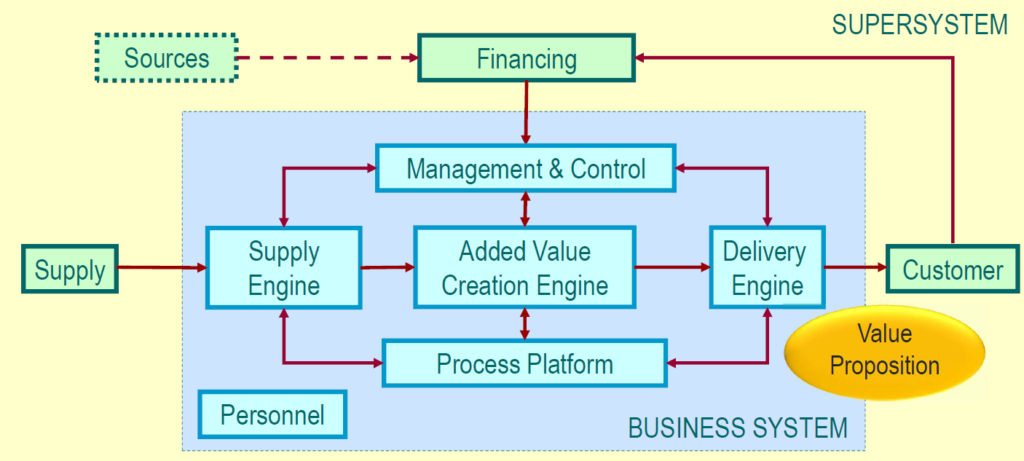
The main assumption that was postulated when developing a strategic session program is that the value proposition of a commercial organization should maximally meet the requirements of the main stakeholders of the business system and key supersystems (Figure 1). The methodology for conducting a strategic session, proposed in this work, is based on this assumption.
The purpose of the strategic session is to develop a set of measures to solve the initial strategic purpose posed by the customer.
Examples of strategic sessions purposes:
1. How, while maintaining the quality of bread production significantly reducing the capital intensity of production and the required area of the enterprise to scale up the business?
2. How to increase revenues at least 10 times for a startup «Fightingnet»?
3. How to provide Russia’s strategic projects with unique equipment in the face of increasing sanctions pressure of USA?
4. Development of measures to support the construction industry in the Ural Federal District in the face of restrictions associated with COVID-19 in 2020 in Russia etc.
2.The sequence of actions during the strategic session and the applied TRIZ tools.
The strategic session is holding in the following sequence:
1. Statement of the strategic goal as a problem.
2. Schematization of the inventive situation [3].
3. Selecting key stakeholders.
4. Determining the requirements of key stakeholders.
5. Choice of the target hypothesis.
6. Determination of the degree of compliance with the requirements of stakeholders in the framework of the selected target hypothesis.
7. Definition of gaps.
8. Selection of preliminary solutions for bridging the gaps.
9. Determination of secondary undesirable effects.
10. Modeling contradictions.
11. Resolution of contradictions.
12. System assembly and analysis of the obtained transformations.
Below is a table of the correspondence of TRIZ tools to the performed action from the above sequence (Table 1).
Table 1. Correspondence of TRIZ tools to the performed action from the sequence during the strategic session.
| N | Activity | TRIZ tools and other tools |
| 1 | Statement of the strategic goal as if a problem. | Administrative contradiction [13].Description of innovative situation. |
| 2 | Schematization of the inventive situation [4]. | Schematization [4]. |
| 3 | Selecting key stakeholders. | Schematization [4]. |
| 4 | Determining the requirements of key stakeholders. | MPV-analysis [5]. |
| 5 | Choice of the target hypothesis. | See bellow |
| 6 | Determination of the degree of compliance with the requirements of stakeholders in the framework of the selected target hypothesis. | MPV-analysis [5]. |
| 7 | Definition of gaps. | MPV-analysis [5]. |
| 8 | Selection of preliminary solutions for bridging the gaps. | Brain storming [7].List of Contradictions in ITB form. |
| 9 | Determination of secondary undesirable effects. | Brain storming [7].List of Contradictions in ITB form. |
| 10 | Modeling contradictions. | Technical contradictions. |
| 11 | Resolution of contradictions. | Contradiction analysis [3].Inventive Principles [10].IFR + Resources for business TRIZ [4]. |
| 12 | System assembly and analysis of the obtained transformations. | Mind Map [8].Multicriterial matrix of solutions [2].Ideas Landscape [2]. |
3.Choice of the target hypothesis.
Table 1 shows that you should use existing TRIZ-tools. There are materials described TRIZ tools mentioned in paragraph 4 of this paper.
There is only a step in the proposed algorithm to describe in detail. It is the point 5 in the table 1.
This tool is not specific to TRIZ. Nevertheless, we have added this tool to the toolkit of strategic sessions for a reason. The fact is that strategic sessions are always associated with forecasting tasks, with an attempt to look into the future. And the future, as you know, is always vague. The word «vague» should be understood as a problem with many unknowns. So, the target hypothesis is designed to convert some of the variables into constants through the formulation of hard constraints. In this case, we are not trying to predict any events, but artificially translate some of the variables into constants. In such cases, consideration of the degree of compliance of the system under study with the requirements of stakeholders may turn out to be much easier, and even the search for intermediate solutions — and even more so, becomes obvious.
Here are some examples of such strategic assumptions.
Example 1:
In solving the problem of stabilizing the construction industry during the COVID-19 pandemic in 2020, we introduced the assumption that strict restrictions will last for at least 3 years (fortunately for everyone, in reality, everything turned out to be not so bad).
Example 2.
In the problem of the multiple growth of the bakery’s business, the most important hypothesis was introduced:
The quality of the product remains unchanged. Hence, the task immediately arose in a new formulation: how to preserve the quality of the product, by several times reducing the capital intensity of production and the required area with the aim of further scaling up the business?
Why is that? The fact is that this enterprise has reached great heights in terms of product quality, its products have won all kinds of competitions. In this case, it was the correct focus during the strategic session.
Example 3.
Introduction of alternative hypotheses in the problem of developing a strategy for a distribution company under sanctions restrictions from the United States.
• we conditionally believe that the sanctions completely cut off access to European and American equipment. Further, we assume that this resource is 100% closed for us.
• we conditionally believe that without European and / or American equipment, in the next 5 years, large customers will not be able to solve their strategic tasks. Further, we work with the assumption that this equipment will need to be imported into Russia in any case, and the country will solve this problem at the state level.
Since the work was carried out specifically with commercial organizations, the first hypothesis was chosen about the complete prohibition of the import of this equipment into the territory of the Russian Federation, as the most unfavorable option. All the solutions found subsequently corresponded precisely to this hypothesis.
4. Case.
Case «How to continue deliveries of unique equipment in the face of increasing USA sanctions pressure»?
The case was supplied by a distribution company. Published with restrictions. The material has been partially changed. The course of the solution is shown before contradictions are revealed. Recommendations resulting from the session are not listed in this paper.
4.1. Administrative contradiction.
Problem: in the context of the sanction’s restrictions, difficulties arise with the supply of equipment for company X.
Required: to develop measures to preserve the distribution business.
System composition: company, suppliers, competitors, legal framework, consumers in the target area.
Limitations: solutions must be in the legal framework.
4.2. Schematization of the initial situation.
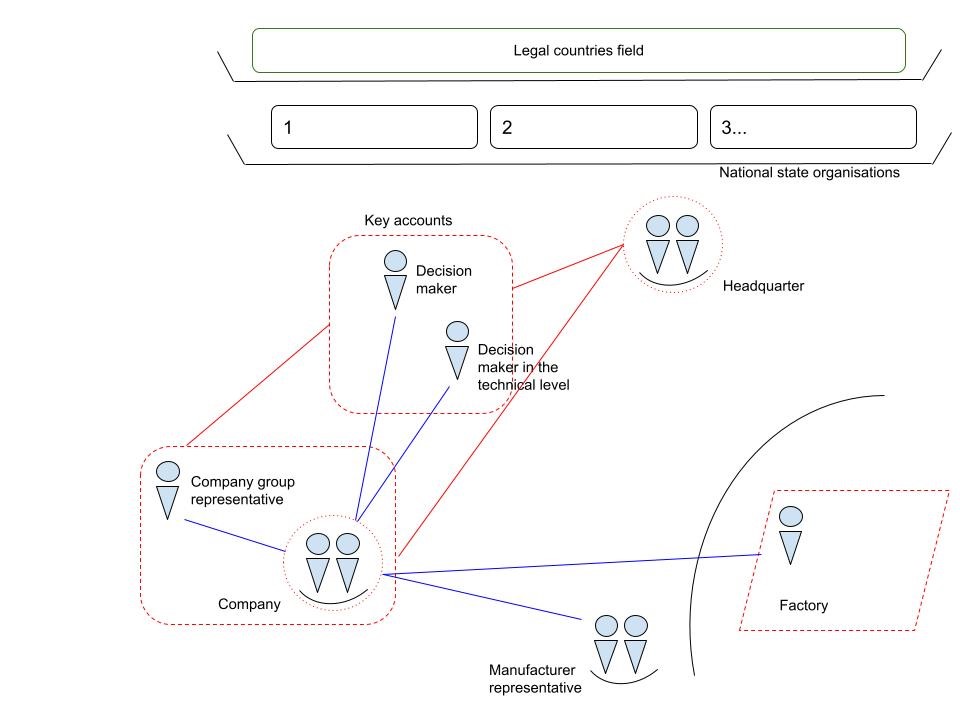
4.3 Highlighting key stakeholders on the diagram.
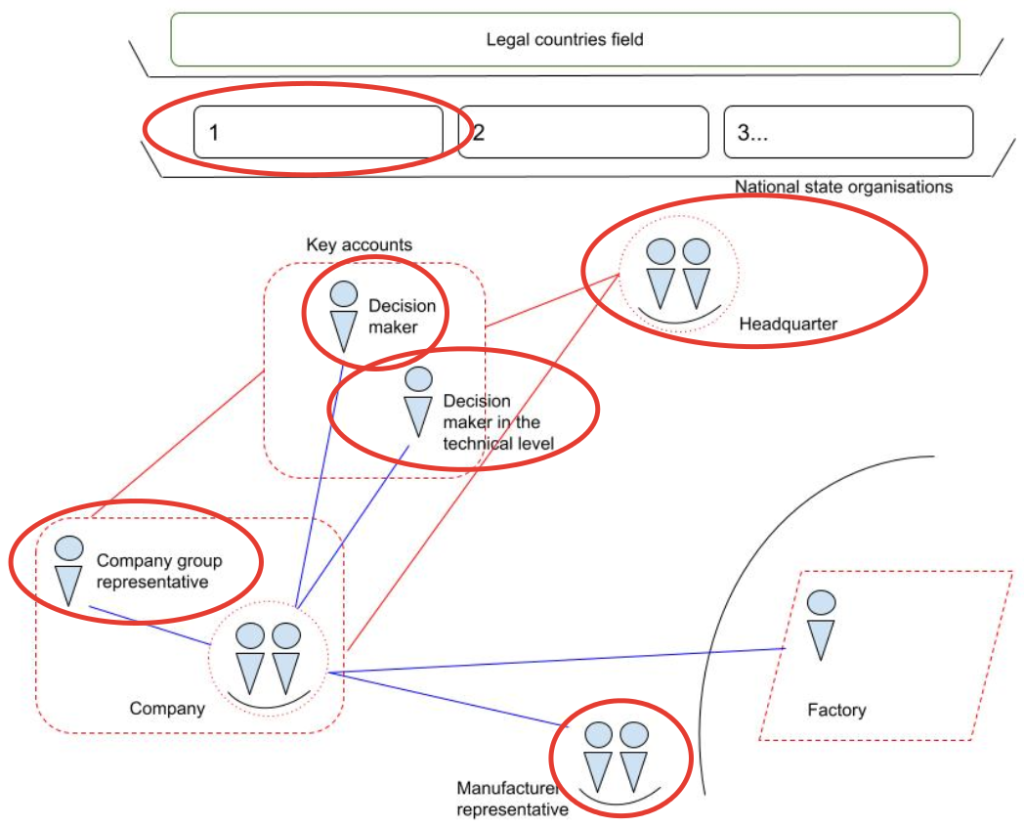
4.4 Determination of the Stages of the process life cycle.
Process: purchase of unique equipment.
Main steps:
• Determination of the need according to the requirements of the State Program.
• Working out the task with the customer.
• Working with the criteria for making a decision of the customer.
• Coordination and entry into the purchasing plan.
• Tender.
• Contract and placing an order with the manufacturer.
• Delivery according to the contract.
4.5 Definition of stakeholder’s MPVs.
There are stakeholders (figure 3) in lines and stages of the process life cycle in columns.
Table 2. Definition of stakeholder’s MPVs [4].

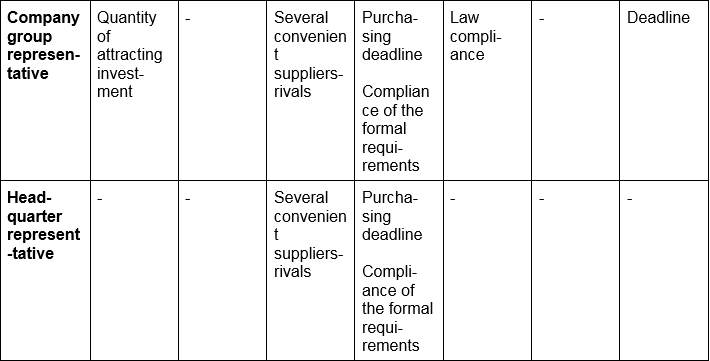

4.6 Choice of the target hypothesis.
• Hypothesis 1. We conditionally believe that the sanctions completely cut off access to necessary equipment. Further, we assume that this resource is 100% closed for the target area.
• Hypothesis 2. We tentatively believe that without necessary equipment in the next 5 years, large customers will not be able to solve their strategic tasks. Further, we work with the assumption that this equipment will need to be imported in the target area in any case, and the government will solve this problem at the state level.
• Solution: choose the first hypothesis as the most unfavorable option.
4.7 Determination of the degree of compliance of the process with the requirements of the stakeholders, considering the chosen hypothesis. Identifying gaps.
Table 3. Determination of the degree of compliance of the process with the requirements of the stakeholders.

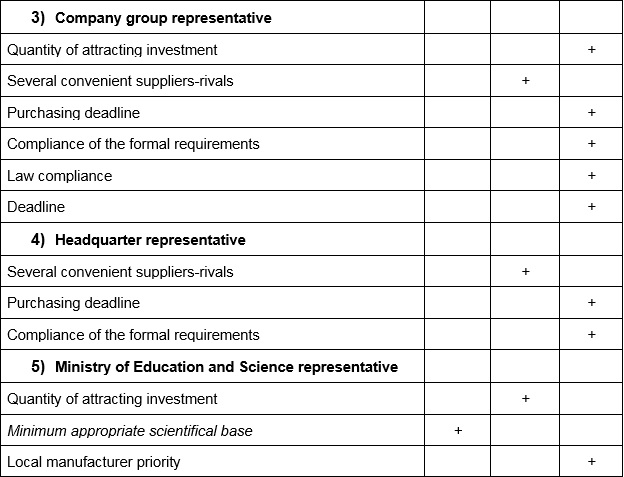

Notice:
- Gaps are in italics.
- MPVs of manufacturer representative are not considered further since it depends on the current situation and cannot influence it.
4.8 Determination of harmful effects and identification of contradictions. Modeling contradictions in the ITB format.
Further, we consider only gaps, and we try to find a previous solution by brainstorming with an expert team. After that, we are determining the second harmful effects to get contradictions.
Unfortunately, not all previous solutions in this work can be published. In some cells of the matrix, intermediate solutions have been removed and replaced with the entry «SOLUTION N …».
Table 4. List of contradictions.
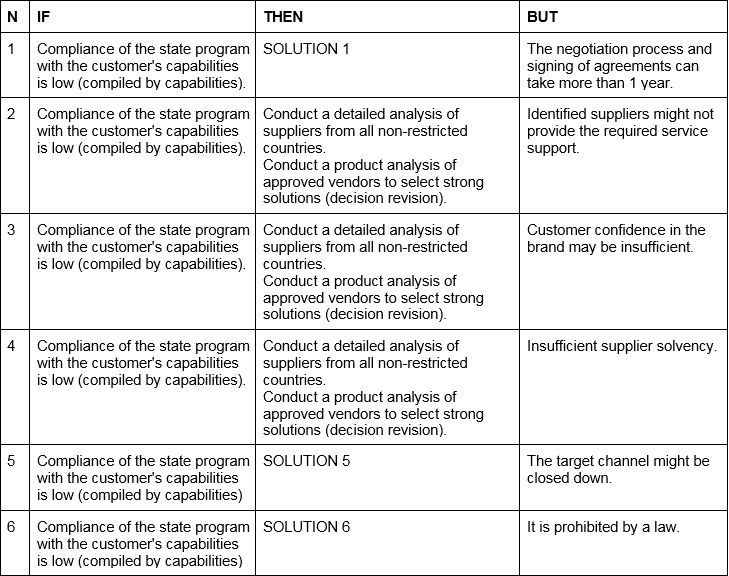
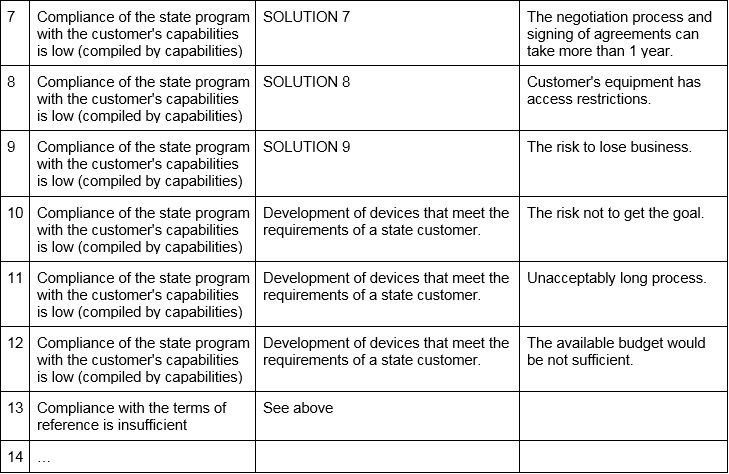
You get the goals of the strategic session after resolving of all contradictions. After doing that you must sum up all solutions with the one mind map [8] to analyze them before getting the road map.
5. Discussion
The strategic session is not always held using the technologies described in this article. It happened that we had to use the system operator [13], flow analysis [4], functional analysis for business systems [15], as well as the concept of ideality and the IFR in order to find innovative solutions at the upper level of the problem statement (this option was present in our practice, and it worked very successfully).
Even though the author conducted most of the strategic sessions according to the technology presented in these guidelines, as follows from the above paragraph, deviations from it are quite common.
A separate subject should be considered the use of lines of systems development in strategic sessions, specially developed for business systems. This tool belongs to TRIZ predictive tools and its use for such tasks is self-evident.
In addition, a promising direction is a synthesis of TRIZ tools with traditional methods of business analysis, including methods that are actively used in the IT environment in the conceptual design of software products.
We invite interested specialists to the discussion.
6. References
- Turn. Proven Market Capture Technique / Luke Williams. — M .: Mann, Ivanov and Ferber, 2012.
- V. Soushkov. TRIZ and Systematic Business Model Innovation, Bergamo University Press. 2010.
- TRIZ: solving business problems / A.P. Kozhemyako, 3rd ed. — M .: University «Synergy», 2021.
- TRIZ: a practical guide for business / A.P. Kozhemyako. — M .: University «Synergy», 2021.
- A. Efimov. MPV analysis technique, 2008
- V. Soushkov. Value-Conflict Mapping ™ (VCM). To Define and Structure Innovation Strategy, 2008.
- Breaking the template: how to find and implement breakthrough ideas / Tina Seelig. — M .: Mann, Ivanov and Ferber, 2015.
- T.K. Tee, Azman M. N. A., M. Suriani. Buzan Mind Mapping: An Efficient Technique for Note-Taking, 2014.
- A. Kozhemyako, V. Svobodov. TRIZ course of lectures, level 1 MATRIZ, 2021.
- V. Sushkov. 40 innovative techniques. Application in management and business systems, 2015.
- A. Kozhemyako. Course of lectures on Business TRIZ, level 2 IBTA, 2020.
- V. Sushkov. Standard inventive solutions in business and management, 2019.
- G.S. Altshuller. Creativity as an exact science. — M .: Sov. radio, 1979.
- V. Soushkov. Breakthrough thinking with TRIZ for business and management, 2014.
- V. Sushkov. Lines of evolution of business systems and business products, 2019.
- TRIZ business association.
Anton Kozhemyako, TRIZ specialist level 4, e-mail: kap@batriz.com
